In the last few years, private country houses and garages began to be increasingly connected to three-phase power supply networks. This is due to an increase in the number of consumer electrical appliances and their power. Such a connection has two main advantages: higher quality of power supply and balance of the three-phase system - the ability to simultaneously connect several powerful electrical receivers to the network, avoiding the occurrence of phase imbalance.
The essence of this phenomenon is as follows: one or two phase wires are overloaded, and the third is underloaded or not involved at all. Uneven distribution electrical energy in the network leads to the fact that when summing the load resistances in the circuit, an equalizing current and bias voltage arise, which can lead to serious malfunctions of the connected equipment, including its failure. Phase imbalance leads to an increase in energy costs, rapid wear of devices, a reduction in the service life and a decrease in the quality of their work.
RA,RB,RC – active resistance of loads by phase,RA>RB>RC≠0;UA,UB.UC – phase voltages,OUA,O.A.B,OUC – linear voltages.
The use of voltage stabilizers and baluns in three-phase networks allows the power source to generate an EMF of the correct sinusoidal shape with constant power throughout its entire period.
There are three types of three-phase electricity meters:
- Direct inclusion;
- Semi-indirect inclusion;
- Indirect inclusion.
Direct connection meters
This type of metering devices has a current limit of 100 A and is used with a small number and low power of consumers (up to 60 kW) and is connected to the network directly through a terminal block with eight contacts installed in the meter according to the following diagram:
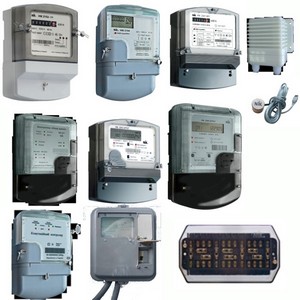
L A ;L B ;L C – phase conductors.N – zero working conductor.
When executing installation work It is extremely important to observe the phasing of the wires - incorrect connections cause additional errors in the device. The alternation of voltage phases is carried out clockwise: ABC – BCA – CAB, correct sequence Wire connections can be determined using a phase meter or a VAF device.
Semi-indirect counters
IN electrical networks, intended for power supply of powerful consumers, such as heat guns, welding equipment, machine tools, etc., metering devices are connected using isolating current transformers. This need is due to the fact that the total load of electrical receivers exceeds the rated current of the meter. Transformers are installed in the gap of the supply wires.
Semi-indirect meters can be installed according to the following common schemes:
- Star connection of current transformers;
- Connection via test block.
The ten-wire circuit provides separate current and voltage circuits, which makes it safe to use and maintain, but it requires a large number of wires.

Contact terminals:
- Phase wires (A; B; C): 1, 4, 7 – input, 3, 6, 9 – output;
- Measuring phase windings (A; B; C): 2, 5, 8 – input;
- Input neutral wire: 10;
- Neutral wire: 11.
Transformer contacts: L 1 – input power line, And 1 – input of the measuring winding, L 2 – output of the power line, And 2 – output of the measuring winding.
PE – grounding conductor, connected to zero bus.
When connected in a star, all outputs of the measuring windings of transformers I 2 converge into one current node and are connected to the 11th terminal of the meter. The output terminals of phase wires 3,6, 9 and the input terminals 10 of the neutral wire are interconnected and connected to the neutral bus.

According to the PUE, clause 1.2.23, the metering device circuits must be output to self-assembly or individual sections in a general row of clamps. If they are absent, a test block (block) must be used, which allows short-circuiting the secondary windings of the current transformers, de-energizing all current circuits device during its maintenance or replacement and connect the reference meter with the load on. The device connection diagram is ten-wire; the test unit is installed between the meter and the transformers.
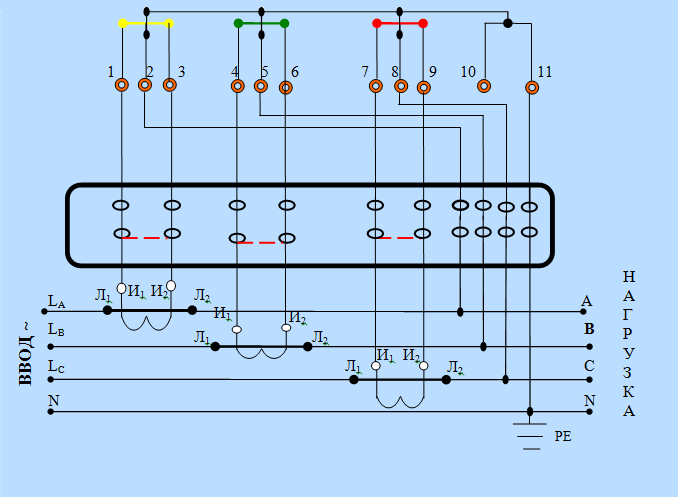
There is also an outdated seven-wire meter connection diagram, in this case its primary and secondary circuits galvanically connected by copper jumpers, which poses a threat to personnel electric shock when servicing equipment, therefore the use of this method is extremely undesirable.

Indirect switching meters are used in industrial conditions and are not found in households.
How to choose a three-phase meter?
First, you need to make sure that the connection of the device is provided for by the type of power supply network - three-phase meters can be used in four-wire networks 220/380 V or 230/400 V. Next, you should set the operating current of the meter based on the size of the load taken into account by the device, which corresponds to the rated current of the input circuit breaker premises.
Significant energy savings can be achieved by using multi-tariff meters that have a “day-night” position and calculate electricity consumption at night at reduced tariffs. A significant advantage will be the presence of an internal tarifficator and power profile in the device, which makes it possible to manage tariff transitions, record the load schedule and keep track of the power consumption values of electrical receivers at any time period. Also, when choosing a meter great value has its accuracy class (from 0.2 to 2.5) and temperature range(from – 20º C to 50º C).
Installation work for installing a three-phase meter
There are two ways to mount a meter in a switchboard:
- With three screws (for housing types S or Ш);
- On DIN rail (R. or P housings).
In the second installation option, the position of the DIM rail is adjusted so that all mounting holes in the device platform and in the shield coincide.
A correctly chosen meter is the main assistant in saving. To do right choice When purchasing, the first thing you have to decide is single-phase or three-phase. But how do they differ, how does installation occur, and what are the pros and cons of each?
In a word, single-phase ones are suitable for a network with a voltage of 220V, and three-phase ones are suitable for a voltage of 380V. The first of them - single-phase - are well known to everyone, as they are installed in apartments, administrative buildings and private garages. But three-phase, which were previously used in most cases in enterprises, are increasingly being used in private or country houses. The reason for this was the increase in the number of household electrical appliances requiring more powerful power.
The solution was found in the electrification of houses with three-phase cable inputs, and to measure incoming energy, many models of three-phase meters equipped with useful features. Let's deal with everything in order.
Perform electricity metering in two-wire networks AC with voltage 220V. And three-phase - in three-phase alternating current networks (3 and 4-wire) with a nominal frequency of 50 Hz.
Single-phase power is most often used for electrification of the private sector, residential areas of cities, office and administrative premises, in which the power consumption is about 10 kW. Accordingly, in this case, electricity metering is carried out using single-phase meters, big advantage which is the simplicity of their design and installation, as well as ease of use (taking phases and readings).
But modern realities are such that over the past couple of decades the number of electrical appliances and their power has increased significantly. For this reason, not only enterprises, but also residential premises - especially in the private sector - are connected to three-phase power. But does this actually allow you to consume more power? According to the technical conditions for connection, it turns out that the power supply from a three-phase and single-phase network is almost equal - 15 kW and 10-15 kW, respectively.
The main advantage is the ability to directly connect three-phase electrical appliances, such as heaters, electric boilers, asynchronous motors, powerful electric stoves. More precisely, there are two advantages at once. Firstly, with a three-phase power supply, these devices operate with higher quality parameters, and secondly, “phase imbalance” does not occur when several powerful electrical receivers are used simultaneously, since it is always possible to connect electrical appliances to a phase that is free from drawdown through “distortion”.
The increase in the need for three-phase power has led to an increase in the installation of three-phase meters. Compared to single-phase ones, they have higher accuracy of readings, but they are also larger in size and more complex in design, requiring a three-phase input.
The presence or absence of a neutral wire determines which meter will need to be installed: a three-wire one if there is no “zero”, and if there is one, a four-wire one. For this purpose, there are corresponding special symbols in its marking - 3 or 4. Direct and transformer connection meters are also distinguished (for currents of 100A or more per phase).
To get a clearer idea of the advantages of single-phase and three-phase meters over each other, you should compare their pros and cons.
Let's start with where three-phase is inferior to single-phase:
- a lot of hassle in connection with the mandatory obtaining of permission to install a meter and the likelihood of a refusal
- Dimensions. If you previously used single-phase power with a meter of the same name, you should take care of the place for installing the input panel, as well as the three-phase meter.
Advantages of three-phase design
Watch a video about the advantages of a three-phase network:
Let us list the advantages of this type of counter:
- Allows you to save money. Many three-phase meters are equipped with tariffs, such as day and night, for example. This makes it possible from 11 pm to 7 am to use up to 50% less energy than with a similar load, but during the daytime.
- Possibility of choosing a model that corresponds to specific wishes for the accuracy class. Depending on whether the purchased model is intended for use in a residential area or in an enterprise, there are names with an error of 0.2 to 2.5%;
- The event log allows you to notate changes regarding voltage dynamics, active and reactive energy and directly transmit them to a computer or the corresponding communication center;
 There are only three types of three-phase meters
There are only three types of three-phase meters
- Counters direct connection , which, like single-phase ones, are connected directly to a 220 or 380 V network. They have a throughput power of up to 60 kW, a maximum current level of no more than 100 A and also provide for the connection of small-section wires of about 15 mm2 (up to 25 mm2)
- require connection via transformers, therefore suitable for higher power networks. Before you make payment energy consumed, you just need to multiply the difference in the meter readings (present with previous ones) by the transformation coefficient.
- Indirect switching meters. Their connection occurs exclusively through voltage and current transformers. They are usually installed at large enterprises, as they are designed for energy metering through high-voltage connections.
When it comes to installing any of these meters, there may be a number of difficulties associated with them. After all, if for single-phase meters there is a universal circuit, then for three-phase meters there are several connection diagrams for each type. Now let's look at this clearly.
Direct or immediate switching devices
The connection diagram for this meter is in many ways (especially in terms of ease of implementation) similar to the installation diagram single-phase meter. It is listed in technical passport, as well as on back side covers. The main condition for connection is strict adherence to the order of connecting the wires according to the color indicated in the diagram and the correspondence of odd wire numbers to the input, and even numbers to the load.
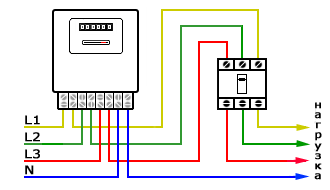
The order of connecting the wires (indicated from left to right):
- wire 1: yellow - input, phase A
- wire 2: yellow - output, phase A
- wire 3: green - input, phase B
- wire 4: green - input, phase B
- wire 5: red - input, phase C
- wire 6: red - output, phase C
- wire 7: blue - zero, input
- wire 8: blue - zero, output
Semi-indirect counters
This connection occurs through current transformers. Exists large number schemes for this inclusion, but the most common among them are:

- The ten-wire connection diagram is the simplest, and therefore the most popular. To connect, you must follow the order of 11 wires from right to left: the first three are phase A, the second three are phase B, 7-9 for phase C, 10 are neutral.
- Connection via terminal box - it is more complicated than the first one. The connection is made using test blocks;
- A star connection, like the previous one, is quite complex, but requires fewer wires. First in common point The first unipolar outputs of the secondary winding are collected, and the next three from the other outputs are directed to the meter, the current windings are also connected.
Indirect meters
Such meters are not installed for residential premises; they are intended for use in industrial enterprises. Responsibility for installation rests with qualified electricians.
Which device should you choose?
 Although most often those who want to install a meter are literally informed about which model is required for this and it is very problematic to agree on its replacement, despite its obvious non-compliance with the requirements, it is still worth learning the basics of the criteria that a three-phase meter must meet in terms of its characteristics .
Although most often those who want to install a meter are literally informed about which model is required for this and it is very problematic to agree on its replacement, despite its obvious non-compliance with the requirements, it is still worth learning the basics of the criteria that a three-phase meter must meet in terms of its characteristics .
The choice of a meter begins with the question of its connection - through a transformer or directly to the network, which can be determined by the maximum current. Direct connected meters have currents of the order of 5-60/10-100 amperes, and semi-indirect ones - 5-7.5/5-10 amperes. The meter is also selected strictly according to these readings - if the current is 5-7.5A, then the meter should be similar, but not 5-10A, for example.
Secondly, we pay attention to the presence of a power profile and an internal tarifficator. What does this give? The tariffifier allows the meter to regulate tariff transitions and record the load schedule for any time period. And the profile records, records and stores power values over a period of time.
For clarity, let’s consider the characteristics of a three-phase meter using the example of its multi-tariff model:
It should be noted that today three-phase meters are widely used for single-phase networks and vice versa: when three single-phase ones are connected to a three-phase network at once.
The accuracy class is determined in values from 0.2 to 2.5. The larger this value, the greater the percentage of error. For residential premises, class 2 is considered the most optimal.
- nominal frequency value: 50Hz
- meaning rated voltage: V, 3x220/380, 3x100 and others
If, when using an instrument transformer secondary voltage equals 100V, a meter of the same voltage class (100V) is required, as well as a transformer
meaning full power voltage consumption: 5 VA, and active power— 2W
- rated-maximum current value: A, 5-10, 5-50, 5-100
- maximum value of total power consumed by current: up to 0.2VA
- inclusion: transformer and direct
- registration and accounting of active energy
In addition, the temperature range is important - the wider it is, the better. Average values range from minus 20 to plus 50 degrees.
You should also pay attention to the service life (depending on the model and quality of the meter, but on average it is 20 -40 years) and the inspection interval (5-10 years).
A big plus will be the presence of a built-in electric power modem, with the help of which indicators are exported via the power network. And the event log allows you to notate changes regarding voltage dynamics, active and reactive energy and directly transmit them to a computer or the appropriate communication center.
And most importantly. After all, when choosing a meter, we first of all think about saving. So, to really save on electricity, you should pay attention to the availability of tariffs. According to this feature, meters are available in single, double and multi-tariff types.
For example, two-tariff ones consist of a combination of positions “ “, continuously replacing each other according to the schedule “7 a.m. -11 a.m.; 11 am -7 am” respectively. The cost of electricity at night tariff is 50% lower than during the day, so it makes sense to operate appliances that require a lot of energy (electric ovens, washing and dishwashers etc.) precisely at night.
Practical advice on how to connect a three-phase electricity meter
Connecting the meter of this type carried out through introductory circuit breaker three-phase type (containing three or four contacts). It is worth immediately noting that replacing it with three single-pole ones is strictly prohibited. Switching phase wires in three-phase switches must occur simultaneously.
In a three-phase meter, the wiring connection is as simple as possible. So, the first two wires are the input and output of the first phase, respectively, similarly, the third and fourth wires correspond to the input and output of the second, and the fifth and sixth - the input and output of the third phase. The seventh wire corresponds to the input neutral conductor, and the eighth - to the output of the neutral wire to the energy consumer in the premises.
Grounding is usually allocated to a separate block and is made in the form of a combined PEN wire or PE wire. Best option, if there is a separation into two wires.
Now we will analyze the installation of the meter step by step. Let's assume that there is a need to replace a three-phase direct-connection meter.
First, let's determine the reason for the replacement and the time for it.
It is preferable to replace the meter during the daytime for the simple reason that the lighting during this period is much better than from using a flashlight. This means that it will be more convenient and faster to carry out the work, which cannot but affect your wallet if you have to use the services of a paid electrician.
After this, it is necessary to relieve the voltage by changing the position of the switch on the circuit breaker.
After making sure that the phases have been removed, we dismantle the old electric meter.
The difficulties that may arise when installing a new meter are related to how different the manufacturers and models of the old and new meters are, and at the same time their shapes and dimensions.
We perform a preliminary fitting of the new meter, placing it within the perimeter of contact between the surface (wall) of the mounting and the body of the electric meter itself. It is important here that the side mounting holes of both of them coincide.
If the preliminary check showed some inconsistencies, we eliminate them by adding suitable mounting holes, extend the wires if the terminals of the new meter are located a little further, etc.
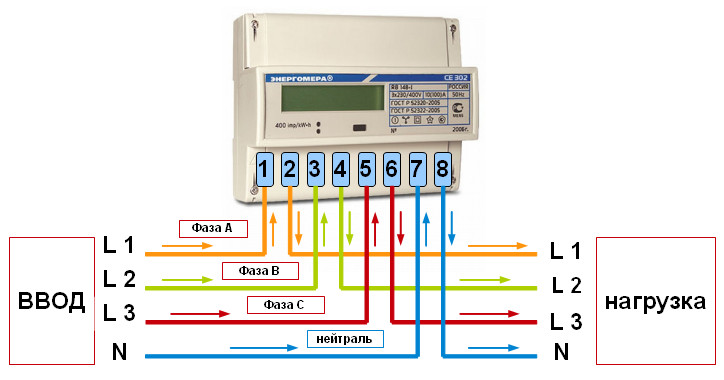 Now that everything fits together, let's start connecting. The connection sequence is as follows (from left to right): the first wire is phase A (input), the second is its output; the third is the input, and the fourth is the output of phase B; similarly - the 5th and 6th wires, corresponding to the input and output of phase C, the last two - the input and output of the neutral conductor.
Now that everything fits together, let's start connecting. The connection sequence is as follows (from left to right): the first wire is phase A (input), the second is its output; the third is the input, and the fourth is the output of phase B; similarly - the 5th and 6th wires, corresponding to the input and output of phase C, the last two - the input and output of the neutral conductor.
Further installation of the electric meter occurs in accordance with the instructions supplied with it.
Among the precautions, which, considering the seriousness of the consequences, should be strictly adhered to, the main place is given to the taboo on any kind of amateur activity - the creation of unintended jumpers; actions that may lead to disruption of normal contact, etc. It is necessary to carefully ensure that the wires are well stretched.
It should be remembered that the meter can only be connected by a qualified electrician who has permission to carry out such work. After installation is completed, the meter will be sealed by a specialist.
Video about the practice of connecting a three-phase meter
In conclusion - briefly about the main points
- The advantage of single-phase meters is the simplicity of their design and installation, as well as ease of use (taking phases and readings)
- But three-phase ones have the highest accuracy of readings, although they are more complex in design, have large dimensions and require a three-phase input.
- Allows you to save money. Thanks to tariffs such as day and night, from 11 pm to 7 am you can use up to 50% less energy than with the same load, but during the day.
- Possibility to select accuracy class. Depending on whether the purchased model is intended for use in a residential area or in an enterprise, there are items with an error of 0.2 to 2.5%
- The event log allows you to notate changes regarding voltage dynamics, active and reactive energy and directly transmit them to a computer or the corresponding communication center
- The presence of a built-in electric power modem, with the help of which indicators are exported via the power network.
Three-phase meter Mercury
Very often it is necessary to connect powerful electrical appliances designed to be connected to a three-phase network. We have to search for and implement appropriate connection diagrams for one phase of these power tools. Therefore, when designing a home power supply network, it is better to plan a three-phase system. The high cost of the cable, meter and documents will more than pay for itself in the future, not to mention the other advantages of the three phases described below.
The advantage of a three-phase system
- In a regular network, when a large load is turned on, voltage surges and drops are observed and electrical noise is created. In a three-phase network, vulnerable digital equipment can be powered from a separate phase by connecting powerful electrical appliances to other lines;
- if one phase breaks during a storm, and normal operation for the rest, the house will not be left without power supply - you can connect the carrier from another outlet;
- with the same power consumption, a three-phase electric motor produces less work in single-phase operation, which is explained by a drop in efficiency by additional scheme, and inefficient operation of the windings.
Operating principle
Power P is equal to the product of voltage U and current I, P=U*I. The principle of accounting for consumed energy can be considered using the example of a single-phase classic meter. There are two coils in it, one connected in series (ampere), the other in parallel (voltage), create induction eddy currents in the aluminum disk, electromagnetic interaction causes it to rotate, and transmit this rotation to the counting mechanism.
This device implements U*I multiplication. Nowadays, such meters are outdated, and they have been replaced by electronic ones, which are more accurate and reliable. In a three-phase meter, in each individual phase the power consumption is measured, which are summed up in a general indicator.
Preferential tariff
Thanks to the emergence electronic devices electricity metering, it became possible to create two-tariff meter. It is known that at night power consumption is much lower than at peak times. This is true both for an individual user and for the scale of the state’s energy system.
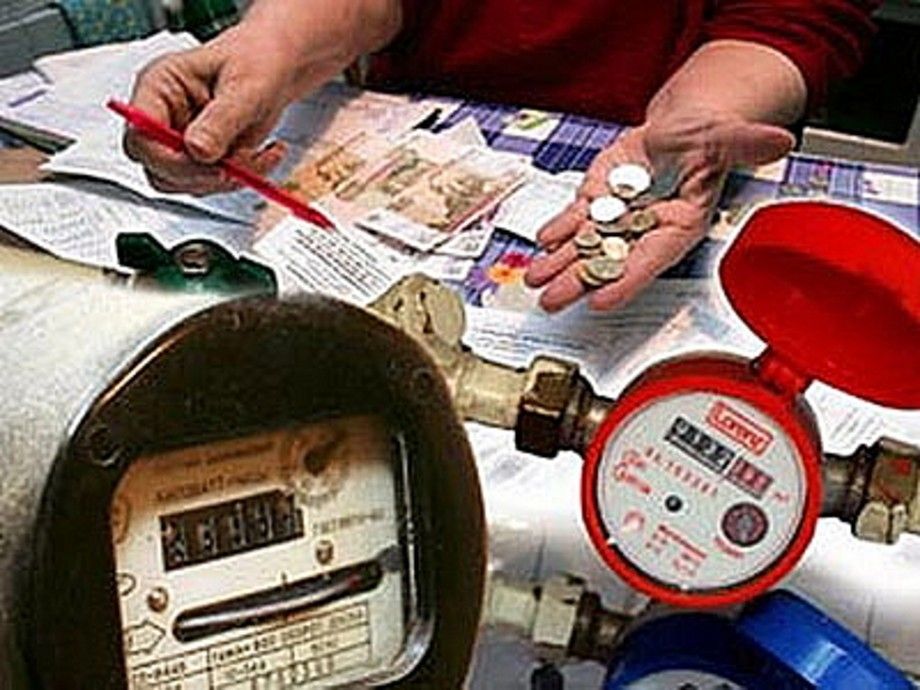
Accordingly, electricity production should be different at different times of the day. This is achieved by increasing or decreasing the power of thermal power plants, which requires additional labor costs of specialists and excessive fuel consumption. Therefore, the state encourages more even electricity consumption throughout the day.
Phase sequence
Input from power lines is usually carried out with a color-coded cable. Each color must correspond to a phase: A, B, C, or L1, L2, L3. It is important that the three-phase meter is connected correctly; the phases must be located in this order. Phasing is determined by a special device - a phase indicator.

Phase indicator
It will give an error and you will have to swap the two conductors. Since the connection process should only be carried out when relieved tension, the electrician needs to know the phasing on the power line in advance.
Installation and connection
The electric meter is installed in a special electrical panel, which has mounting holes for mounting the electrical appliance. In case of installation outside the building, the meter is installed in a sealed electrical box.
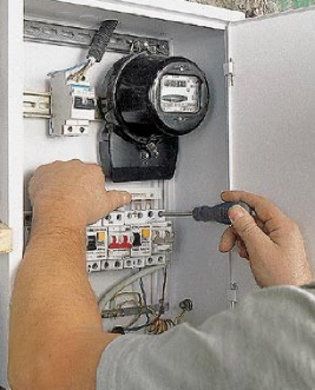
The supply cable from the power line must be solid and go either directly into the meter or through a preliminary circuit breaker. In this case, an electrical panel is used, in which the compartment with the machine and the meter is separately closed and sealed.
Independent electrical work It should be done only in accordance with the project, with the permission of the relevant services, otherwise they may not sign the documents and not allow the equipment to be used.
Schematic diagram
There are several types of inclusion:
- direct (immediate);
- indirect;
- semi-indirect.
For domestic needs and power connections of less than 60 kW, only direct, direct connection is used.
How to connect a three-phase meter becomes clear after studying the connection diagram of this device, which is always available on the device itself and in the device passport. The drawing shows how three phases enter and exit the meter: A, B, C and neutral N - neutral wire, eight contacts in total.

Windings of a three-phase electric meter
The input terminals are connected to the input cable, respectively, to the phase conductors and neutral:
- No. 1-A1;
- No. 3-B1;
- No.5-C1;
- No. 7 - to the incoming zero reason N.
Output contacts (load):
- No. 2-A3;
- No. 4-B3;
- No.6-C3;
- No.-8 - zero.
Some meters, such as old induction meters, may have a different switching circuit; you need to carefully study it first.

Visual diagram of connecting a three-phase meter
Practical implementation
The wires from the meter to the machines must be copper, insulated, type VVG, with a cross-sectional area of at least 6 mm². Bend the conductor (bending radius of at least ten wire diameters) in in the right places at right angles, leading to the appropriate terminals, cut off the required length. Carefully strip the ends of the conductor, without damaging the metal, of insulation to a length no less and no longer than the length of the wire entering the contact socket.
Perform this procedure with each wire, it is better to select them individual colors for each phase. Connect the corresponding terminals with prepared wires, tightening the terminal groups of contacts well to prevent burning.
The meter may have several tightening bolts in each terminal; start tightening from the top one. Also, do not overtighten these clamps, so as not to break them during installation; use reasonable force, checking the reliability of the wire by hand.
You need to make sure that the wires go all the way into the socket; sometimes you need to first unscrew the clamping bolts. The wires should not sag or be stretched. The machines are mounted on a special DIN rail.
Connect and seal
It is better to make the connection according to this algorithm - from the input circuit breaker, phase A to the meter terminal No. 1, connect its output No. 2 with a wire of the same color to the output circuit breaker. Repeat this sequence for each phase.
The zero connection is also carried out - to the meter at contact No. 7 from the zero terminal or a bolt on the case (depending on the project and local regulations), the zero output from the meter is from contact No. 8 to the zero bus or the zero contact of a four-pole machine.
The conductors should be bent so that they do not touch - such a measure will increase the reliability of the entire connection.
All work must be carried out in accordance with safety regulations, using suitable tools to avoid damaging the cable, terminals and clamping bolts. The sealing of the meter by the officials completes the entire installation process.
The neutral wire must be grounded before entering the meter, that is, connected to a grounded metal electrical panel, or a grounded neutral terminal, to prevent failure of the meter and electrical equipment due to phase imbalance, when the zero burns out at the substation and voltage appears on it, and the entire load from neighbors rely on this grounding. It is imperative to pay attention to this aspect when coordinating the project with representatives of the electricity supplier.
You also need to remember that in home networks with a third PE grounding wire, it is strictly forbidden to connect it to the incoming neutral, only to a separate grounding circuit.
Some electricity meters can themselves send energy consumption parameters to the metering service, without the need to manually take readings. The possibility of such a service and the appropriate brand of device should be checked at your place of residence.
General instructions and the procedure for installing meters:
Counters can only be used for permanent installation in closed, easily accessible rooms without aggressive vapors and gases.
Meters must be mounted on walls or panels that are not subject to vibration. Recommended height from the floor is 1.4 - 1.7 m.
In rooms where contamination and mechanical damage are possible, meters are installed in safety cabinets.
Secure the meter with three screws (deviation from vertical position no more than 1°).
It is necessary to turn on the meters in full accordance with their nominal data and the markings of the windings, which are available both on the terminal box and on the diagram located on inside the terminal box cover, and also observe the specified phase sequence (the meter connection diagram is shown below).
During installation, you should especially ensure reliable contact of the connected wires and connections between serial and parallel circuits meter (in the clamp box).
Installation, dismantling, repair, verification and marking of the meter must be carried out only by specially authorized organizations and persons.
For transformer meters, on the additional shield attached to the front side of the terminal block cover of the meter, when installing the meter into operation, the transformation ratios for current and (or) voltage of the measuring transformers, complete with which the meter must work, are indicated, and the coefficient K=Knapr* is also applied. Kcurrent, equal to the product of the coefficients of the voltage and current measuring transformers, by which the readings of the counting mechanism must be multiplied in order to obtain the true electricity recorded by the meter. When using only current transformers, the voltage coefficient Kvolt = 1. The application of coefficients and sealing of the cover is carried out by organizations and persons authorized to do so.
Reactive energy meters are manufactured with a stopper reverse. At the customer's request, active energy meters can be manufactured with a stopper. The presence of a reverse stopper on the counter is indicated on the shield of the counting mechanism in accordance with GOST 25372-95.
The meter plate shows the nominal and maximum currents meter, for example: 10 - 40A, where 10A is the nominal current, 40A is the maximum meter current. For transformer meters, only the rated current is indicated.
The presence of readings on the counting mechanism at the time of purchase is a consequence of the adjustment and verification of the meter at the factory, and not evidence of its operation.
Don't allow short circuits in the network, current overloads above 200% of the rated value for transformer meters, and for direct connection meters - current values higher than the maximum indicated on the panel. Violations lead to additional errors, and significant ones lead to meter failure.
It is prohibited to place foreign objects on the meter, hit or throw the meter.
When checking, installing and operating the meter, the requirements of the “Safety Rules for the Operation of Consumer Electrical Installations” must be observed.
Scheme of direct connection of the meter
Connection diagram for a meter using two current transformers
Connection diagram for a meter using three current transformers
According to the requirements of the rules for electrical installations: “newly installed single-phase meters must have fillings
state verification with a limitation period of no more than 2 years, and on three-phase meters - with a limitation period of no more than 12 months."
First of all, this means that the electric meter you purchase should already have two seals (one seal can be installed on an electronic meter). You should check the presence of these seals. They are often installed on the screws securing the casing of the electric meter, and there are two types: external or internal. External seals are made of lead, less often of plastic, clamped on a wire threaded through a screw or eyelet. 
Internal fillings consist of black or red mastic poured into a screw recess, sometimes coated with silver. 
All seals must have a clear imprint and be free from mechanical damage, which should be noted special attention upon purchase. A duplicate of the state verifier's imprint in the form of a seal is usually affixed to the last pages of the electricity meter passport. 
The stamp of the seals indicates the year of verification of the electric meter, or rather the last two digits of the year and the attributes of the state verifier on a small scale between the numbers. On external seals, to all this, on the reverse side is added the quarter of the verification year, printed in Roman numerals. Therefore, after looking at the year of verification of the meter on the seals, you need to make sure that it is not expired, that is, no more than two years have passed for a single-phase meter and no more than 12 months for a three-phase meter.
It also often happens that there are two seals installed on the meter, but one has the stamp of the state verifier, and the other has the stamp of the quality control department of the manufacturer, which is considered quite acceptable. But if both seals have a quality inspection stamp, or it is not clear which one at all, then you should not buy such an electric meter, since before installing it, you will have to take it to the standardization and metrology center for verification and, accordingly, pay additional money. You will have to do the same if you buy a meter with expired government seals. That's all about fillings.
The first thing you need is an electricity meter. energy supply company, and the consumer is obliged to install it in an apartment, house, garage or country house. Mostly single-phase appliances are installed in apartments. A three-phase meter is usually connected in private homes.
Many meters have been installed for a long time and require replacement. The main reasons for this are as follows:
- end of service life;
- loss of measurement accuracy (below second class);
- the need to install a multi-tariff device.
Installation of a new meter can be done with the help of professionals or independently. There are no particular difficulties here, but the rules must be followed.
Which counter should I choose?
Previously, mechanical type meters (induction) were manufactured. Their production continues to this day, installation is permitted by energy supply companies. Old designs are already being replaced by electronic digital devices. Both options do the same job, but mechanical ones are less resistant to low temperatures. It is important that the device passes through which should not be lower than the second.
How to connect a three-phase meter?
The three-phase electricity meter is connected from the appropriate supply network. 
It is required in a house equipped with an electric boiler, machine tools, electric stove and other powerful equipment. A distribution cabinet with protective devices for one and three phases is installed at the entrance. The input from the external network consists of 4 or 5 wires, where 3 current-carrying, neutral and ground wires are used. Grounding can be installed separately.
The three-phase meter is connected to the network directly or through step-down voltage and current transformers. They are installed in the power part of the circuit when the circuit power is higher than that of the device. Direct connection is made with three current-carrying wires of the network L1, L2, L3 and neutral wire N (picture below). The phase and zero outputs on the terminal block are shown as L1", L2", L3" and N". Each output terminal is located next to the input terminal. 
Nowadays many models are produced, the number of terminals and circuits of which may differ. For example, the connection of a three-phase meter "Mercury 233" from the input side is made to terminals 1, 4, 7, 10. Therefore, it is necessary to pay attention to the diagram indicated in the device passport. The connection of the three-phase meter "Energomera" is done according to the usual scheme described above.
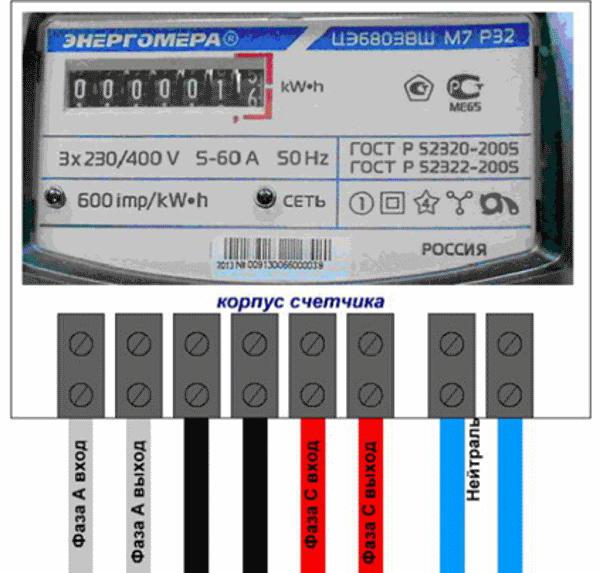
Important! The power consumption is indicated in the passport for the meter. If it is exceeded, this may cause failure of the device and even fire. To select a suitable counter, you must first calculate total power consumer devices. It is taken with a reserve if the load is expected to increase in the future.
Features of connecting a three-phase meter
The features of the procedure are:
- You must first purchase all components for installation: switchboard, electric meter, automatic machines, RCD.
- For safe servicing of the metering device, it is necessary to install
- The external power cable is first connected to the input circuit breaker.
- From the machine, three phases are connected to the meter, and after it, through an RCD, to the load.
- When connecting the cable, do not confuse the phase and neutral conductors.
- Grounding to the device is connected to the RCD.
Rules for connecting an electric meter
Since the metering device is primarily needed by the energy supply company, all actions related to the connection are carried out with the participation of its representatives. You can do the installation yourself, but at the last stage you need to call an inspector. When working, you must remember the following:
- Installation is subject to strict rules and regulations that management company requires compliance.
- Seals from the manufacturer and the energy supply company are required so that the consumer cannot change the connection diagram. After sealing, you need to receive an acceptance certificate.
If the meter is installed without the participation of the energy supply organization, it will not be considered a monitoring device. This will be an ordinary electrical device, like an RCD or an automatic device.
Connecting a three-phase meter "Mercury 230"
The frequently installed Mercury meter is characterized by many different functions. It measures reactive energy in both directions. Various modifications allow you to calculate energy according to one or several tariffs, as well as remember information over a long period of operation. Main characteristics of the meter:
- Possibility of selecting a device based on maximum strength and rated current, as well as by accuracy class;
- accounting for bidirectional energy consumption;
- availability of event logs and indicators;
- the interval between verifications is 10 years;
- service life - up to 30 years;
- availability of interfaces and modem.

Connection diagrams
The connection of the three-phase meter "Mercury 230", as well as all others, can be done directly to the network wires or through if there is not enough power. There are 8 terminals for connecting the cores. Terminals 1, 3, 5 are used to connect three input phases. Usually they come from an input machine, which reacts to surges in mains voltage. Each of them is followed by load wire 2, 4, 6. The input and output of the neutral wire are connected to the seventh and eighth terminals, respectively.
Electric current flows from the output phase terminals 2, 4, 6 to single-phase devices. Cables must be marked.
Important! The marking of the cores is carried out taking into account the colors, so that in the future the user does not make mistakes when laying them through machines, RCDs and further to the loads.
Instructions: connecting a three-phase meter
The sequence of actions is as follows:
- An overhead or underground cable is laid from the power line to the house to the input machine. This must be done by specialists.
- The electric meter is installed along with the rest protective equipment. Depending on the number of consumers, machines with poles from one to four are fixed. To make the circuit more compact, you can use differential automata instead of an RCD.
- From a four-pole input circuit breaker, colored wires are connected to the input terminals of the meter.
- The wires are connected in the same sequence internal network to the output terminals. The input and output connected to adjacent terminals must be the same color.
- Connecting a three-phase meter with an RCD. The phase and neutral wires are connected to the latter in the sequence corresponding to its circuit.
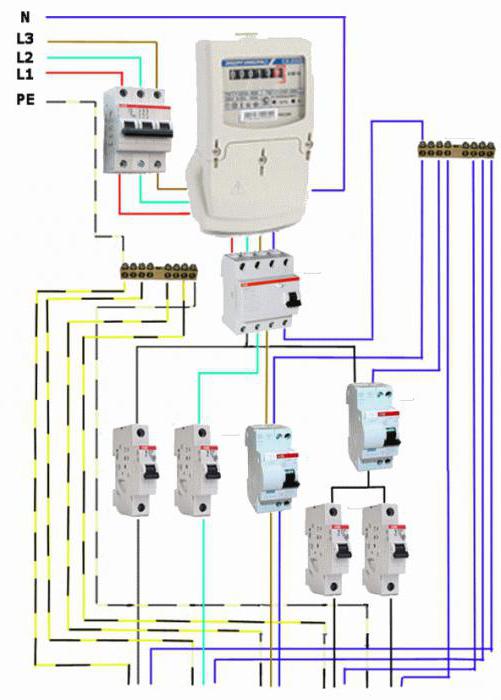
Before you begin work on installing electrical wiring inside the panel, you should definitely check the disconnection and blocking of accidental switching on of the voltage at the input. The serviceability of the insulation on the tool handles is also checked.
It is not allowed to connect a three-phase direct connection meter, the power of which is lower than that consumed by the home network. To do this, you need to first calculate maximum load and select the appropriate device. It is advisable to purchase it with a power reserve.
Conclusion
Connecting a three-phase meter to a home household network done directly. All models have the same connection diagram. It can be found in the device passport and on the back of the terminal cover.
